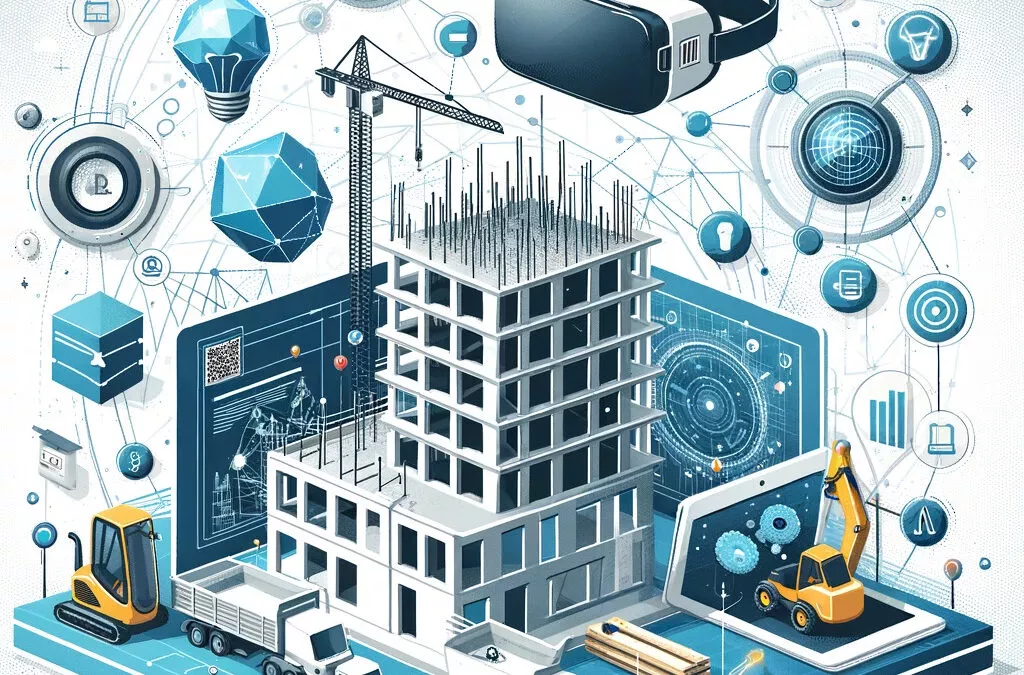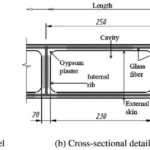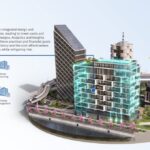
Building Information Modeling (BIM) is quickly becoming a game-changer in the world of construction. This digital tool, which allows the creation and management of 3D models for construction projects, has transformed the way architects, engineers, and contractors collaborate and plan their projects. Whether you’re designing a new skyscraper, renovating an office building, or managing a large infrastructure project, BIM offers unparalleled advantages that streamline workflows, reduce costs, and improve project outcomes.
In this blog, we will dive deep into the many uses of BIM and why it’s essential for the future of the construction industry.
What is BIM?
BIM, or Building Information Modeling, is a digital representation of a building’s physical and functional characteristics. Unlike traditional 2D CAD drawings, BIM creates a 3D model that includes detailed information about a building’s design, structure, systems, and performance. This 3D model is not just a visual representation but a comprehensive dataset that can be used throughout the entire lifecycle of a building—from planning and design to construction and facility management.
Uses of BIM in Construction
- Design Visualization: One of the most powerful aspects of BIM is its ability to create realistic 3D models. Architects and engineers can visualize the entire design before any physical work begins, allowing them to detect potential issues early in the process. The ability to view the building from various angles, zoom in on details, and explore different materials or finishes gives project teams a deeper understanding of the final result.
- Collaboration and Coordination: BIM is designed to foster collaboration between various stakeholders, including architects, engineers, contractors, and owners. By working from a shared 3D model, teams can communicate more effectively, ensuring that everyone is on the same page. Changes made by one team member are instantly visible to all others, reducing the risk of miscommunication and errors.
BIM enables clash detection, which allows teams to identify and resolve conflicts between different systems (such as plumbing, electrical, and HVAC) before construction begins. This helps prevent costly delays and change orders later in the process.
- Cost Estimation and Budgeting: BIM can be integrated with cost management tools to create more accurate cost estimates. By linking the 3D model to a detailed database of materials, quantities, and labor costs, contractors can generate precise estimates based on the actual design, reducing the risk of budget overruns. Additionally, BIM can help track costs throughout the construction process, providing real-time data for project managers to make informed decisions.
- Construction Planning and Scheduling: With BIM, construction planning becomes more efficient. 4D BIM integrates the 3D model with time-based data to create a dynamic project schedule. This allows teams to visualize the sequence of construction activities, track progress, and adjust schedules in real time. The 4D model can be used to simulate construction workflows, optimize resource allocation, and identify potential delays or bottlenecks.
- Facility Management and Maintenance: BIM is not just useful during the design and construction phases; it’s also a valuable tool for building operation and maintenance. After construction is complete, the BIM model can be handed over to the building owner or facility manager, who can use it for ongoing maintenance. The model contains detailed information about the building’s systems, equipment, and materials, allowing for more efficient maintenance, repairs, and upgrades.
- Sustainability and Energy Efficiency: BIM can be used to optimize a building’s energy performance. By simulating how a building will perform under different conditions, BIM helps designers make more informed decisions about energy-efficient systems, insulation, and materials. BIM can also integrate with energy modeling tools to analyze the environmental impact of different design options, helping teams achieve sustainability goals like LEED certification.
- Risk Management: BIM helps improve risk management by providing a comprehensive, real-time view of the entire project. Potential issues can be identified early, and teams can take proactive measures to mitigate risks. For example, using BIM to model complex structures can help identify safety hazards and allow for the planning of safer construction procedures.
Benefits of BIM
- Improved Accuracy and Reduced Errors: BIM helps eliminate common mistakes that can occur in traditional construction, such as miscalculations, clashes between building systems, or misinterpretation of plans. Since all project data is stored in one model, the chances of errors are greatly reduced.
- Faster Project Delivery: With better collaboration, more accurate cost estimates, and more efficient scheduling, BIM helps speed up project delivery. By minimizing rework and reducing delays, BIM can shorten construction timelines, allowing projects to be completed faster and more efficiently.
- Cost Savings: Although the initial investment in BIM software and training may be substantial, the long-term savings can be significant. By reducing errors, improving collaboration, and optimizing project management, BIM can help save money throughout the construction process. Additionally, BIM can help with post-construction maintenance, reducing future repair costs.
- Better Decision-Making: With real-time access to project data, stakeholders can make better-informed decisions. BIM provides a clear view of project progress, costs, schedules, and risks, enabling teams to make adjustments as needed. This leads to more effective problem-solving and fewer costly surprises.
- Enhanced Communication: BIM promotes better communication among all stakeholders by providing a single source of truth. Project teams can share the model with clients, contractors, subcontractors, and even regulatory authorities, ensuring everyone is aligned. This reduces misunderstandings and ensures the project stays on track.
The Future of BIM in Construction
As technology continues to evolve, BIM is expected to become even more integrated with other emerging technologies like artificial intelligence (AI), augmented reality (AR), and Internet of Things (IoT). These technologies will further enhance the capabilities of BIM, enabling smarter, more efficient buildings and infrastructure.
The use of BIM is also growing beyond construction projects to include urban planning, infrastructure management, and disaster response. As cities become more complex and interconnected, BIM’s role in managing and optimizing the built environment will only increase.

How BIM is Transforming the Construction Industry: Applications and Benefits
Building Information Modeling (BIM) has evolved from a niche technological tool to a cornerstone of modern construction practices. As the construction industry becomes more complex and demands for higher efficiency increase, BIM offers a streamlined solution to manage and execute projects with precision and accuracy.
In this blog, we explore the ways in which BIM is transforming the construction industry, from design through to post-construction.
What Makes BIM So Powerful?
At its core, BIM is a comprehensive digital representation of a building or infrastructure. It integrates architectural, structural, and MEP (mechanical, electrical, and plumbing) data into a single 3D model. Unlike traditional methods, where design, construction, and operational processes are often fragmented, BIM allows for better coordination and collaboration across all phases of a project.
Key Applications of BIM in Construction
- Design and Visualization: BIM enables architects and designers to create highly detailed 3D models that represent a building’s appearance and functionality. These models can be rotated and viewed from any angle, providing a much clearer understanding of the design compared to traditional 2D blueprints. This visual accuracy helps prevent errors in interpretation and ensures that the design aligns with the client’s vision.
- Clash Detection: One of the biggest challenges in construction projects is ensuring that the different systems (plumbing, HVAC, electrical, etc.) fit within the building’s structure without interference. BIM software can perform clash detection, identifying any conflicts between systems early in the design process. This allows teams to address problems before construction begins, reducing costly rework and delays.
- Project Scheduling (4D BIM): Beyond 3D modeling, BIM can integrate time-based data, creating a 4D model that helps visualize the construction schedule. This dynamic scheduling allows construction teams to simulate the entire construction process and optimize workflows, ensuring that projects are completed on time.
- Cost Estimation and Budgeting (5D BIM): BIM can be integrated with cost estimation tools to create a 5D model, which incorporates budget information into the 3D model. With real-time updates, project managers can monitor cost fluctuations and compare them against the original budget. This ensures that the project stays on track financially and helps prevent cost overruns.
- Facility Management: Once construction is complete, BIM provides valuable information for facility managers. The model can be handed over to the building’s owner, containing details about the building’s systems, materials, and equipment. This data helps in the efficient management of the building, including preventive maintenance and upgrades.
Benefits of BIM in Construction
- Improved Efficiency: BIM reduces time-consuming tasks like manual drafting, simplifying collaboration and project management. The ability to instantly access the latest updates ensures that everyone involved is working with the most up-to-date information.
- Cost Savings: The precise design, budgeting, and scheduling capabilities of BIM lead to fewer mistakes and delays. This reduces rework and helps manage costs more effectively. Additionally, by identifying problems early on, BIM can save money that would otherwise be spent on fixing issues during construction.
- Better Collaboration: BIM fosters better communication between all project stakeholders, including architects, engineers, contractors, and clients. Everyone is working from the same model, which ensures that all parties are aligned and reduces the risk of misunderstandings or miscommunication.
- Sustainability: BIM can help optimize energy use by simulating a building’s energy performance. It can also suggest environmentally friendly design options and materials, contributing to sustainable building practices. As sustainability becomes a central focus in the construction industry, BIM helps in achieving green building certifications like LEED.





